
Why torture equipment on a medical equipment website?!!
As you hopefully know, this website normally deals with medical equipment that is designed to “reduce “ human suffering. However, while on holiday, I visited a museum which had on display some ancient equipment designed to “increase “ human suffering instead. I was shocked and intrigued to discover the extent people went to devise ways to torture fellow human beings. This led me to explore torture equipment and I share below some of the things I found interesting. Of course I am in no way supporting torture. I put this material here only for your curiosity. By the way, just in case you may wonder, I have definitely have not experimented with any of these devices myself !
The ancient line drawings, like the one shown below, are not my own work. I have however added some colour at places. Hope you enjoy the pain!
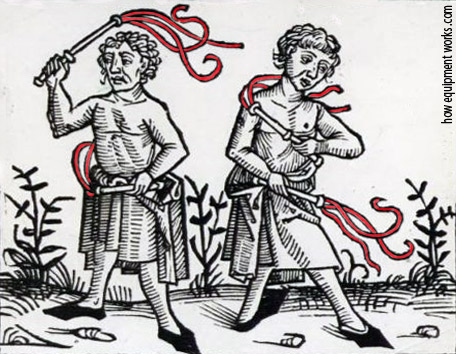
Torture Chair
The torture master greets you with a grin and says, “Have a seat !”
You briefly think, “How kind” and then you quickly realise the truth when you sit. You would feel pain from the hundreds of spikes everywhere on this evil chair. There are straps to prevent you from moving away. To increase the pain, the torture master would apply additional pressure on your body to press you more into the spikes.
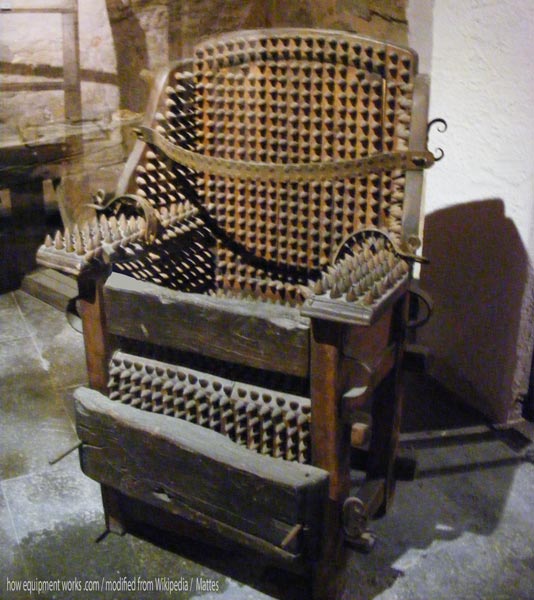
Hollow Metal Bull
A rather cruel ruler called Phalaris lived in ancient Greece about 2600 years ago. An even more cruel inventor made a uniquely horrible instrument of torture for the ruler to use against his people. His invention consisted of a large hollow bull made out of metal. This metal bull had a door that could be opened. The person to be tortured to death would be put inside the bull and the door would be securely closed. Then a fire would be lit underneath the bull to heat it. The person inside would scream as he would burn to death. The metal bull’s mouth had an opening from where the screams of the dying person could be heard. The bull’s mouth was apparently designed in such a way that the screams of the dying man would end up sounding as if the bull was alive and making noises.
The inventor was probably proud of himself as he presented the bull to the ruler. Unfortunately for him, the ruler decided to test the bull using the inventor himself as a test subject. The ruler put the inventor inside the bull and lit a fire underneath. The screams of the inventor satisfied the ruler that the system worked. The ruler pulled the inventor out of the bull to prevent him from dying inside it. Now you might think that the ruler had at least some kindness since he rescued the inventor from death. You would be very wrong if you thought that. After taking him out of the bull, the ruler threw the inventor over a cliff, to his death!
The image below shows a man being tortured. He is being loaded into the bull head first while someone else is preparing a fire underneath.
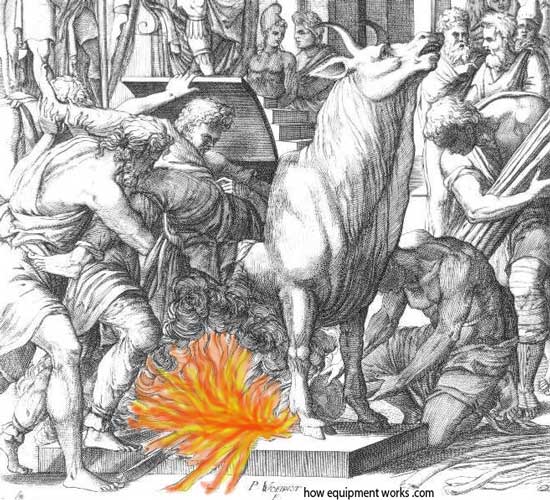
Punishment board (pillory)
Compared to many other forms of torture, this was somewhat less harsh and was reserved for minor crimes. The person to be punished was held in place by a wooden board with holes for the head and hands. This was often done in a public place because the real torture in this case was to humiliate the person in front of others in the community.

While the pillory was a somewhat kind form of torture, unfortunately, the public watching was not always forgiving. They would add to the torture by throwing objects at the person, and these would sometimes result in injury or even death.
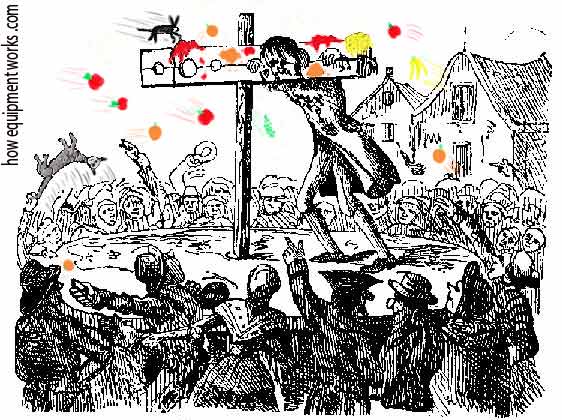
For women who are ‘not peaceful’
A woman who often disturbs the “public peace” by being noisy and argumentative (e.g. quarrelling with neighbours) was called a “common scold”. To be like this was a punishable offence. One of the punishments was to place the offending woman in a special chair attached to a pole. Depending on the severity of her offence, she would be repeatedly dipped into the water, presumably to “cool” her hot temper.


Hello! My name is Pras and I am the author of this website that you are now reading. I have made this website completely free to access so that people from all over the world can benefit from it.
If you can afford it, I would be very grateful if you would consider making a single donation of one dollar (or the equivalent in your currency) to help cover the expenses needed to run this website (e.g. for special software and computers). For this website to survive, donations are desperately needed. Sadly, without donations, this website may have to be closed down.
Unfortunately, perhaps because many people think that someone else will donate, this website gets only very few donations. If you are able to, please consider making a single donation equivalent to one dollar. With support from people like you, I am sure that this educational website will continue to survive and grow.


Torture ‘rack’
From a medical point of view, a little bit of stretching exercises is probably a good thing. However, I would certainly not recommend that you try out the ‘rack’ to get some stretching! The person to be tortured was placed on the rack and the arms and legs were attached to ropes. These ropes were wrapped around cylinders that could be turned. The torturers would then very gradually turn the cylinders of the machine. The turning cylinders would pull the rope, slowly stretching the person and causing great pain. As the torture continued, one would hear the sounds of ligaments and bones breaking.

The rack was used by the “Inquisition”, who were sort of “religious judges”. The Inquisition sentenced people who did not agree with the teachings of the Church. During the time of the Inquisition, which happened during a period of severe religious intolerance, anyone could report a person to the authorities saying that they believed that the person had different beliefs. The accused would then be questioned by the Inquisition. The accused was never told who reported them, was not permitted to have a lawyer, and did not have any supporters with them ( anyone supporting the accused would themselves have become accused !).

If the person being accused did not confess to the crime of not believing, he or she would then be shown some torture equipment to try and frighten them into giving a confession.

If the accused still didn’t confess, they were tortured till they confessed. Once accused, one had to confess, irrespective of if they were guilty or not. There wasn’t any other option!
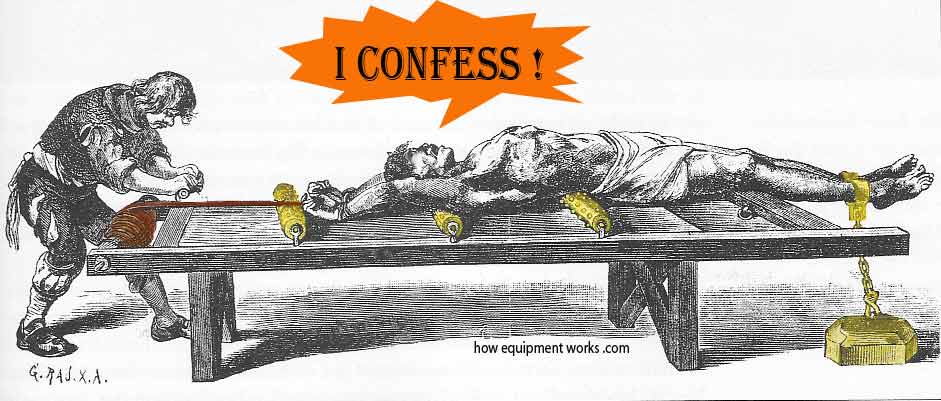
Interestingly, the famous astronomer, Galileo Galilei ( who lived in the years 1564-1642 ) had to face the Inquisition. The Inquisition was concerned about Galileo’s ‘view’ of the Sun.

Galileo supported the theory that the Earth orbits around the Sun. We take this for granted now, but in those days, the religious belief was that the Sun went around the Earth (i.e. that the Earth must be the centre of the Universe).

The Inquisition questioned Galileo about his beliefs, including his support for the theory that the Earth was not the centre of everything.

Fortunately, during the questioning, Galileo was not physically tortured. However, I suppose he must have suffered a lot of mental torture when trying to stick to his scientific views while at the same time trying to please the Inquisition.
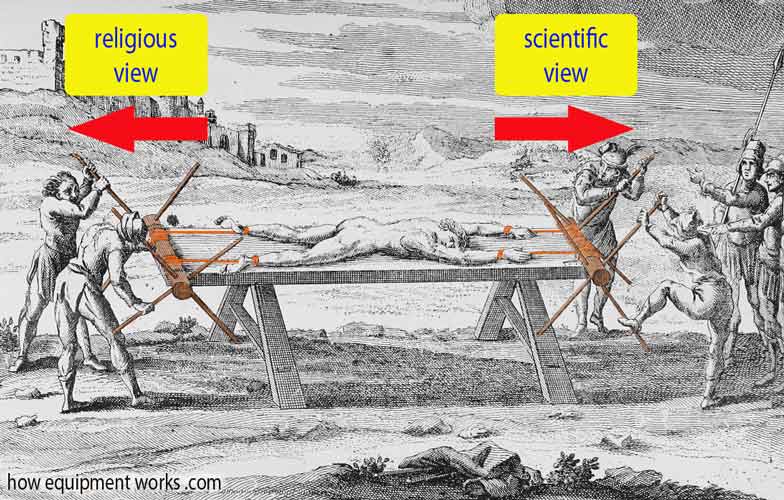
After the questioning, the Inquisition was not convinced that Galileo was going to change his scientific views. He was then sentenced to spend the rest of his life being imprisoned in his home.

Finally, 350 years after Galileo’s death, Pope John Paul II in 1992, expressed regret for how the Galileo affair was handled by the Church and issued a declaration acknowledging the errors made. Since then, the Earth can go around the Sun.
Spike Stool
Many of us (especially anaesthetists !) love to sit on a stool to rest our legs. Unfortunately, not all stools are made the same. The one below (officially called Judas Cradle) was a cruel way to use a stool. The person to be tortured was suspended by ropes and then lowered onto the spike stool. I don’t need to explain to you the physics of how the sharp end of the stool caused severe trauma to certain orifices of the human body.
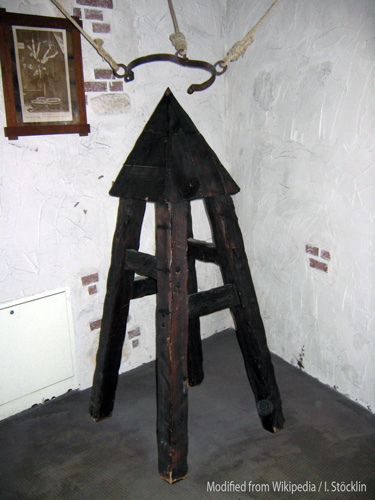
Slow surgeon torture
This is a very unique type of torture that will only be understood by those working in surgical operating rooms. So, if you work elsewhere, you might want to skip this one.
This torture is well demonstrated in the painting shown below (painted by Hieronymus Bosch around the year 1500) which shows an ancient outdoor surgical operating area. The surgeon is wearing a tin hat and the assistant, wearing black, is holding some irrigation fluid. The anaesthetist (symbolically shown to be intelligent by the book drawn over her head) is monitoring the patient. The painting depicts the so-called “slow surgeon torture”. This torture was used by surgeons to torment the anaesthetist. It consisted of the surgeon wasting time (usually by admiring their handiwork) and taking far too long to finish the surgery. The anaesthetist would suffer severe mental pain trying to work out when it would all end.
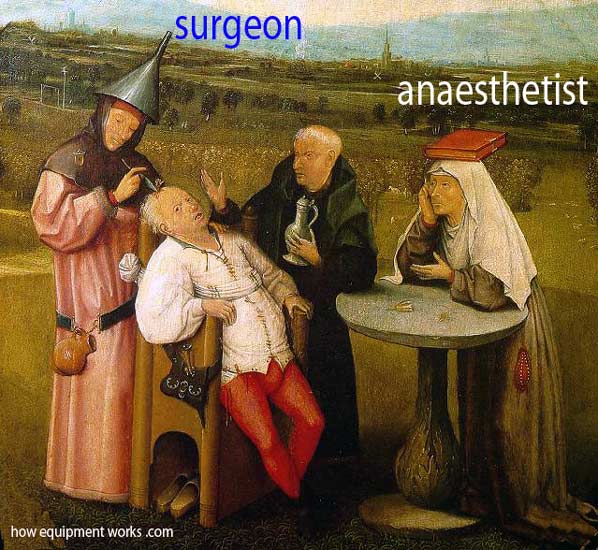
Drunkards barrel
Let us finish our discussion by describing a relatively harmless piece of torture equipment, called the Drunkards Barrel or Drunkards Cloak. This was used to punish people who were repeatedly found drunk.

The torture equipment was made out of barrels used to store alcoholic beverages. Holes were cut in the barrel for the person’s head and arms to go through. He then had to walk around town wearing this and everyone was supposed to humiliate him. Hopefully after the humiliation, he wouldn’t head to the shop to buy more drinks to drown his sorrows!
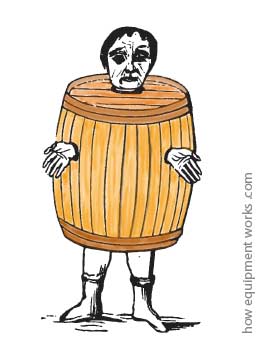
Enough pain?
This brings our brief introduction to ancient torture equipment to an end. I hope it wasn’t too painful. See you later in another section. Bye!

Hello! My name is Pras and I am the author of this website that you are now reading. I have made this website completely free to access so that people from all over the world can benefit from it.
If you can afford it, I would be very grateful if you would consider making a single donation of one dollar (or the equivalent in your currency) to help cover the expenses needed to run this website (e.g. for special software and computers). For this website to survive, donations are desperately needed. Sadly, without donations, this website may have to be closed down.
Unfortunately, perhaps because many people think that someone else will donate, this website gets only very few donations. If you are able to, please consider making a single donation equivalent to one dollar. With support from people like you, I am sure that this educational website will continue to survive and grow.

